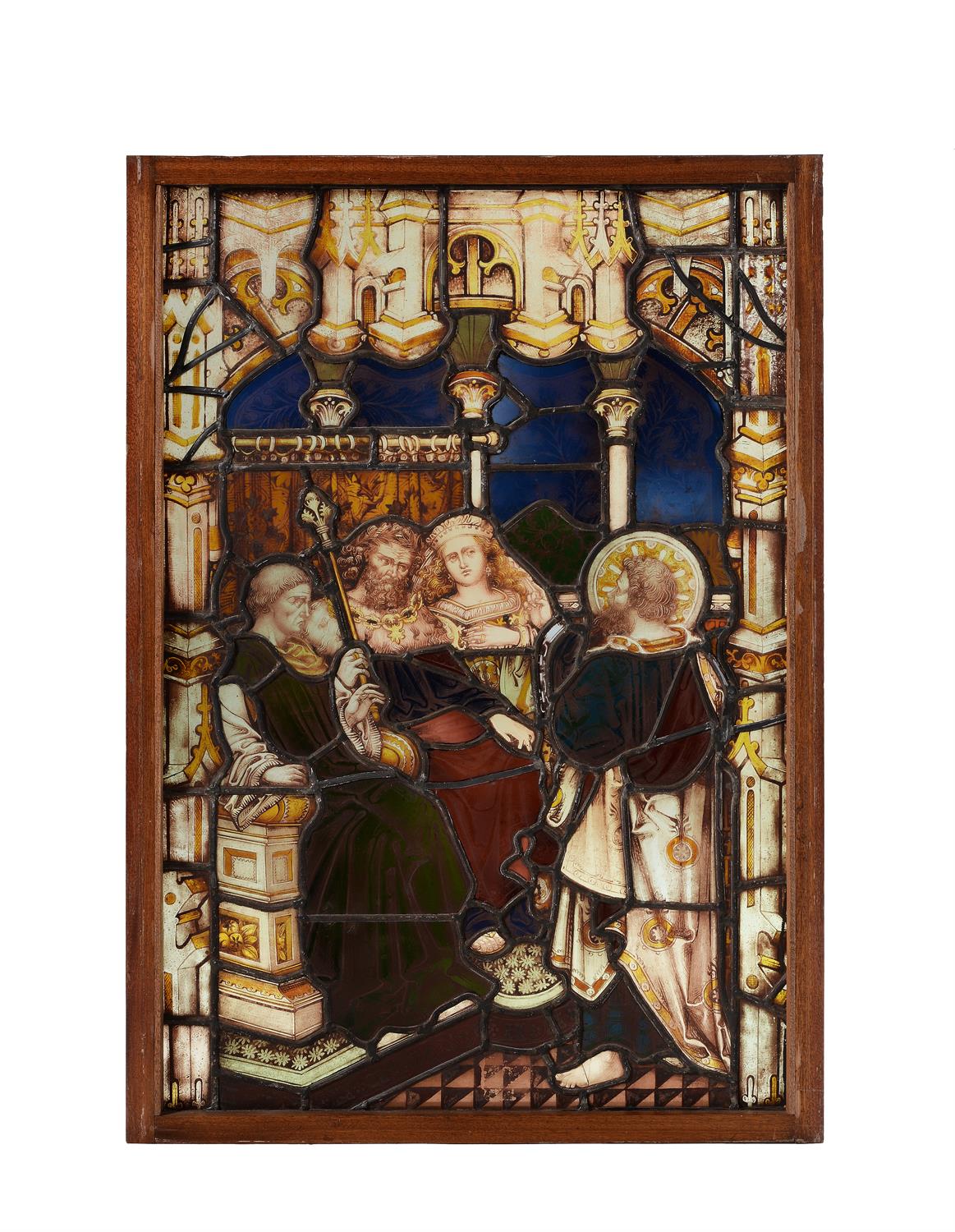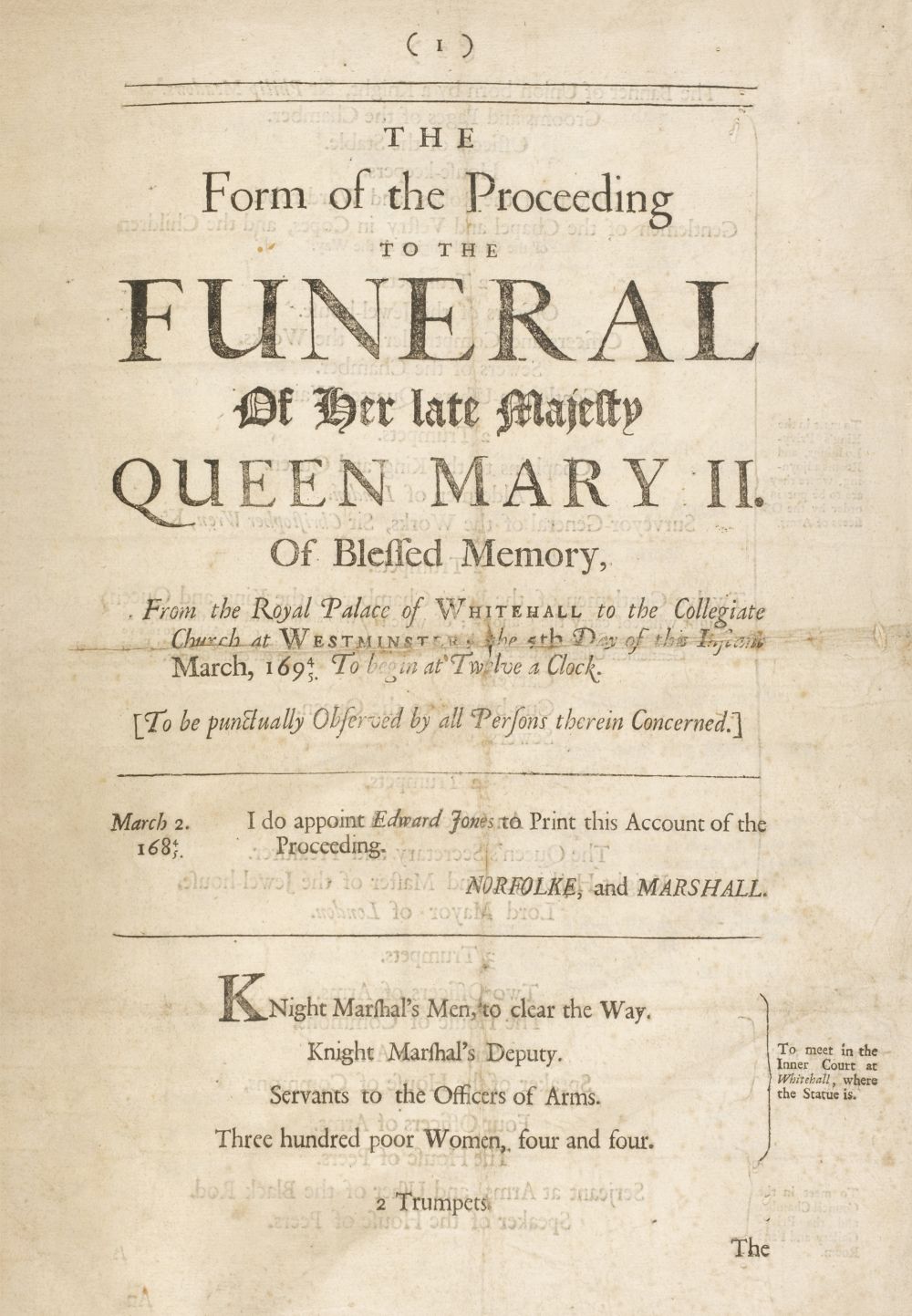ST PAUL(?) and KING SOLOMON: two historiated initials on a leaf from the Villeneuve-lès-Avignon Bible, in Latin, illuminated manuscript on vellum[France (probably Paris), 13th century (2nd half)]
a single leaf, c. 210 × 150mm, written in two columns of 55 lines, the text comprising the usual prologue to Proverbs and the beginning of Proverbs, written in minute gothic script with capitals stroked in red, rubrics in red, with notes to the rubricator slightly cropped at the extreme lower edge, foliated in pencil ‘215’ in the lower corner, illuminated with TWO HISTORIATED INITIALS, ‘C’(romatio et Heliodoro) and ‘P’(arabole Salomonis) depicting, respectively, a balding saint seated on a bench holding a sword, and a seated king holding a whip instructing a tonsured student who reads from a book; cuts in the leaf at the upper and lower edge of the main initial repaired, marginalia in tiny script is mostly erased except for original textual corrections; in a giltwood frame with a photocopy of the verso attached to the back of the frame.
PROVENANCEProduced in Paris, and probably written by a Carthusian or Cistercian scribe, to judge by the use of punctus flexus punctuation (as noted by Ker, 1969, p. xii n. 2: ‘Bibles with flex punctuation are rare’ – referring to leaves from the present manuscript as an example); in light of the subsequent provenance, it was probably written for a Carthusian monk, perhaps of the Chartreuse de Vauvert, founded in 1257 on what is now the site of the Jardin de Luxembourg, Paris.THE CHARTREUSE OF VAL DE BÉNÉDICTION AT VILLENEUVE-LÈS-AVIGNON, founded by Pope Innocent VI in 1356 and suppressed in 1790: the first flyleaf of the parent volume is reported (Maggs, 1962) to have been inscribed ‘Ista biblia est domus cartusiensis in villa nova prope avinionem’ (repeated on the verso of the second flyleaf), below which were a 16th-century inscription and an 18th-cent. ownership stamp: ‘Cartusie Villenovae’. For manuscripts from the Charterhouse see Viellard, 1964, and de Forbin, 1988; a 15th-century Carthusian Breviary from the house was sold in our rooms, 25 June 1985, lot 86.The parent volume was apparently broken up in 1960 or January 1961 by The Folio Society (or by Louis Bondy, as suggested by de Hamel, 2000, p. 51): Maggs apparently acquired at least one leaf from The Folio Society in January 1961, and the latter were offering multiple leaves, of three different types, in their ‘Spring 1961’ catalogue; leaves were being offered by other London bookdealers later the same year.The present leaf was sold in our rooms, 5 December 2012, part of lot 4; bought by:The Boehlen Collection, Bern, MS 1319
ILLUMINATIONThe larger initial has standard iconography for a 13th-century Paris Bible: King Solomon, seated and wearing a crown, threatens his son Rehoboam with punishment while pointing to the latter’s open book. It is therefore all the more surprising that the other initial has a depiction of St Paul (it must be him, to judge by his bald forehead and the way in which he holds his sword): there is no obvious reason for him to be used to illustrate an Old Testament prologue by Jerome.
The style is typical of Parisian illumination of the third quarter of the 13th century, with figures and draperies delineated with black lines, with lead-white for flesh areas and the palette otherwise dominated by dark blue and bright red (perhaps a taste deriving from contemporary stained glass), and gold used sparingly for details such as crowns and halos, and to add sparkle to the outer parts of initials.
A list of about 35 leaves from the parent manuscript, including 16 at the Bodleian Library (MS. Lat. bib. e. 6), is provided by Manion et al., 1989.
REFERENCESThe Folio Society, Catalogue 3: Collectors’ Corner (Spring 1961), no. 108 (a)–(c).
Maggs Bros., European Miniatures and Illumination: Bulletin 2 (London, November 1962), no. 13 (ill.).
J. Viellard, ‘Manuscrits de la Chartreuse de Villeneuve-lès-Avignon conservés à la Bibliothèque Vaticane’, in Mélanges Eugene Tisserant, 7, Studi e testi, 237 (Vatican, 1964), pp. 441–50.
N.R. Ker, Medieval Manuscripts in British Libraries, I: London (Oxford, 1969).
F. de Forbin, ‘Les manuscrits de la chartreuse Villeneuve-lès-Avignon’, in Les Chartreux et l’art, XIVe–XVIIIe siècle, ed. A. Girard and D. Le Blévec (Paris, 1988), pp. 39–63.
M.M. Manion, V.F. Vines, and C. de Hamel, Medieval and Renaissance manuscripts in New Zealand collections (Melbourne, 1989), cat. no. 68.
C. de Hamel, ‘Selling Manuscript Fragments in the 1960s’, in Interpreting and Collecting Fragments of Medieval Books, ed. by L.L Brownrigg and M.M. Smith (Los Altos Hills and London, 2000), pp. 47–55 at 51–52.
ST PAUL(?) and KING SOLOMON: two historiated initials on a leaf from the Villeneuve-lès-Avignon Bible, in Latin, illuminated manuscript on vellum[France (probably Paris), 13th century (2nd half)]
a single leaf, c. 210 × 150mm, written in two columns of 55 lines, the text comprising the usual prologue to Proverbs and the beginning of Proverbs, written in minute gothic script with capitals stroked in red, rubrics in red, with notes to the rubricator slightly cropped at the extreme lower edge, foliated in pencil ‘215’ in the lower corner, illuminated with TWO HISTORIATED INITIALS, ‘C’(romatio et Heliodoro) and ‘P’(arabole Salomonis) depicting, respectively, a balding saint seated on a bench holding a sword, and a seated king holding a whip instructing a tonsured student who reads from a book; cuts in the leaf at the upper and lower edge of the main initial repaired, marginalia in tiny script is mostly erased except for original textual corrections; in a giltwood frame with a photocopy of the verso attached to the back of the frame.
PROVENANCEProduced in Paris, and probably written by a Carthusian or Cistercian scribe, to judge by the use of punctus flexus punctuation (as noted by Ker, 1969, p. xii n. 2: ‘Bibles with flex punctuation are rare’ – referring to leaves from the present manuscript as an example); in light of the subsequent provenance, it was probably written for a Carthusian monk, perhaps of the Chartreuse de Vauvert, founded in 1257 on what is now the site of the Jardin de Luxembourg, Paris.THE CHARTREUSE OF VAL DE BÉNÉDICTION AT VILLENEUVE-LÈS-AVIGNON, founded by Pope Innocent VI in 1356 and suppressed in 1790: the first flyleaf of the parent volume is reported (Maggs, 1962) to have been inscribed ‘Ista biblia est domus cartusiensis in villa nova prope avinionem’ (repeated on the verso of the second flyleaf), below which were a 16th-century inscription and an 18th-cent. ownership stamp: ‘Cartusie Villenovae’. For manuscripts from the Charterhouse see Viellard, 1964, and de Forbin, 1988; a 15th-century Carthusian Breviary from the house was sold in our rooms, 25 June 1985, lot 86.The parent volume was apparently broken up in 1960 or January 1961 by The Folio Society (or by Louis Bondy, as suggested by de Hamel, 2000, p. 51): Maggs apparently acquired at least one leaf from The Folio Society in January 1961, and the latter were offering multiple leaves, of three different types, in their ‘Spring 1961’ catalogue; leaves were being offered by other London bookdealers later the same year.The present leaf was sold in our rooms, 5 December 2012, part of lot 4; bought by:The Boehlen Collection, Bern, MS 1319
ILLUMINATIONThe larger initial has standard iconography for a 13th-century Paris Bible: King Solomon, seated and wearing a crown, threatens his son Rehoboam with punishment while pointing to the latter’s open book. It is therefore all the more surprising that the other initial has a depiction of St Paul (it must be him, to judge by his bald forehead and the way in which he holds his sword): there is no obvious reason for him to be used to illustrate an Old Testament prologue by Jerome.
The style is typical of Parisian illumination of the third quarter of the 13th century, with figures and draperies delineated with black lines, with lead-white for flesh areas and the palette otherwise dominated by dark blue and bright red (perhaps a taste deriving from contemporary stained glass), and gold used sparingly for details such as crowns and halos, and to add sparkle to the outer parts of initials.
A list of about 35 leaves from the parent manuscript, including 16 at the Bodleian Library (MS. Lat. bib. e. 6), is provided by Manion et al., 1989.
REFERENCESThe Folio Society, Catalogue 3: Collectors’ Corner (Spring 1961), no. 108 (a)–(c).
Maggs Bros., European Miniatures and Illumination: Bulletin 2 (London, November 1962), no. 13 (ill.).
J. Viellard, ‘Manuscrits de la Chartreuse de Villeneuve-lès-Avignon conservés à la Bibliothèque Vaticane’, in Mélanges Eugene Tisserant, 7, Studi e testi, 237 (Vatican, 1964), pp. 441–50.
N.R. Ker, Medieval Manuscripts in British Libraries, I: London (Oxford, 1969).
F. de Forbin, ‘Les manuscrits de la chartreuse Villeneuve-lès-Avignon’, in Les Chartreux et l’art, XIVe–XVIIIe siècle, ed. A. Girard and D. Le Blévec (Paris, 1988), pp. 39–63.
M.M. Manion, V.F. Vines, and C. de Hamel, Medieval and Renaissance manuscripts in New Zealand collections (Melbourne, 1989), cat. no. 68.
C. de Hamel, ‘Selling Manuscript Fragments in the 1960s’, in Interpreting and Collecting Fragments of Medieval Books, ed. by L.L Brownrigg and M.M. Smith (Los Altos Hills and London, 2000), pp. 47–55 at 51–52.















Testen Sie LotSearch und seine Premium-Features 7 Tage - ohne Kosten!
Lassen Sie sich automatisch über neue Objekte in kommenden Auktionen benachrichtigen.
Suchauftrag anlegen